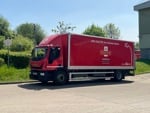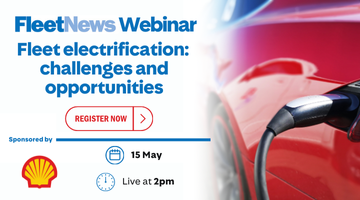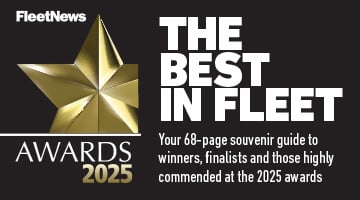IT’S not often we hear of the Inland Revenue deliberately taking people out of a taxable situation. And when you do hear of this, it is generally such big news that it makes lots of column inches in the trade press of the relevant industry.
Yet there has been relatively little written so far about exactly this situation as far as drivers of company vans are concerned. The process is already well in hand to eliminate the tax liability for private use of company vans for the vast majority of the people who pay this tax at present.
Although there have been some minor changes within the last couple of years as part of the overall realignment, the last time this part of income tax was changed was back in 1992. Basically, any employee who had private use of a van provided by their employer was liable to pay tax on a flat fee. This was set at £500 in 1992 – and is still the same today.
The £500 taxable sum could be reduced to £350 if the van in question was more than four years old and there was a sort of pooling or apportionment of the tax liability among several employees if they shared the overall private use of the van during the tax year.
Astonishingly – especially in light of the way fuel for private use of company cars is treated – that £500 charge could, if the employer so wished, include fuel for private use. As with most benefit-in-kind tax charges, drivers pay tax at their normal top rate (22% or 40%), on the value of the benefit charge.
Inland Revenue really started to look at this position seriously a couple of years ago.
Its initial intention was to introduce some form of environmental dimension to the tax, broadly along with the CO2-driven lines of the company car tax system.
However, there is no requirement for manufacturers to publish fuel consumption and CO2 data for vans (even though the information has to be produced to secure vehicle type approval). In the end, Inland Revenue more or less gave up on the idea of an environmental dimension, and took a bold and imaginative step: they decided to more or less do away with the tax altogether.
Note that ‘more-or-less’ bit. Do please read on because unless you make some specific arrangements and can demonstrate that you understand the exemptions, and can comply with them, van drivers may still be liable to pay tax on a benefit charge.
But this time, it will be based on £3,000.
And if fuel for private use is included, there will be another £500 charge on top of that. So it is important that fleet managers with company vans understand what they need to do to optimise the whole position for drivers – and of course the company, through the Class 1A NIC charge.
The new position
THE changes are coming in by stages. From April this year (2005), the whole categorisation of ‘private use’ changed. This is the change that should take the majority of employees who have private use of a van out of the tax net – so there could be immediate savings.
Basically, any employee who has only ‘insignificant’ use of a company van will not have to pay tax on it. Commuting mileage must still be considered, but doesn’t count; drivers don’t have to take the van home for ‘security’ or ‘on-site parking’ reasons; and they don’t have to claim to be on call.
The key issue is that word ‘insignificant’. Somewhat quaintly, the relevant website ww.hmrc.gov.uk/employers/van-tax.htm uses as an example ‘an employee who takes an old mattress or other rubbish to the tip once or twice a year’ as well as taking slight detours on a relatively regular basis to buy a newspaper, or to visit the dentist.
Not perhaps the best examples to pick but it is pretty clear that any irregular and infrequent private use (other than commuting) should not attract a tax charge on the driver – and therefore no Class 1A NIC on the employer.
Conversely, there are examples on the Inland Revenue’s website, now properly defined as the site for ‘Her Majesty’s Revenue & Customs’
(see www.hmrc.gov.uk) of private use which will attract taxation on the driver:
Use of the van to do supermarket shopping on a weekly (or other regular) basis
Taking the van on holiday
Use outside of work for ‘social activities’
There is a great deal of information straight from the horse’s mouth held on the website. It’s not especially easy to find it from the homepage, but the best starting point is headed ‘Company Vans’ and is located at
www.hmrc.gov.uk/vans/index.htm.
There are links to pages for employers, for employees and about the policy aspects and NIC. There is – confusingly – still a lot of information about the old system which applied up until April 2005: this may still be useful for current-year tax returns etc, but be sure to read the page headings.
One vital point is the records that will need to be maintained, in order to prove to the tax-man that no tax is due – assuming, of course, that drivers individually can claim exemption under the new rules.
These records are different from the ones that should still be kept in any event, simply for good fleet management. The HMRC website does indicate some of the types of proof that might be needed, and these should not be onerous for any level of employer.
All the information available from HMRC makes it clear that since they have to cater for all sizes, shapes and levels of sophistication of van fleet operators, they are only looking for reasonable evidence that there is, in practice, not going to be any substantial private use of vans, if drivers wish to avoid tax. All of the examples cited on the website involve nothing more complex than paper-based systems and administrative processes.
What is clear is that relatively simplistic systems will cope and that no great changes should be needed. This is an important point to make, since at this time (mid 2005), there is some evidence of overselling some of the vehicle tracking systems as being necessary to prove no private use.
There are, of course, many very sound business reasons why any van operator might wish to install this kind of equipment. It is pretty obvious there are significant commercial advantages in being able to identify where vehicles have been and when, drivers’ time behind the wheel, drivers’ actual knocking-off times and so on. There are also powerful arguments in terms of the health & safety/duty of care implications of employees – particularly lone, vulnerable or remote ones.
It is beyond reasonable dispute that many of the reports and evidence-streams available from these systems would also serve extremely well to demonstrate the use – or non-use – patterns of vans to Inland Revenue, so far as private use/non-working times were concerned. However, to suggest that Inland Revenue actually requires this level of detail before it would accept that drivers were not, in fact, enjoying any private use, is an entirely different matter.
However the record-keeping is to be made, it is essential that drivers are fully engaged with the whole process. They must appreciate that their record-keeping will play a big part in keeping them out of the tax net – and that should be a pretty big incentive. Just how big will become clearer as the next stage of the tax changes approach.
Short-term future
THE importance of getting the private use policy and the recording arrangements right all in good time becomes apparent when we look at the alternative.
While there are easy ways to avoid the tax legitimately, the penalty for failure will be a large financial cost.
From April 2007 onwards, anyone who has to pay the tax on private use of a company van will see big changes in the tax charge. Because that is going up from the current £500 pa, to a whopping £3,000 pa. And that will NOT include any fuel for private use – if employees get that benefit as well, they will be liable for tax on another £500 on top of the £3,000.
Employers will face full Class 1A NIC on such tax charges (at 12.8%): that makes it imperative to make all the arrangements in plenty of time.
It’s time to start taking action
IT is clear that the willingness of the taxman to lose small amounts of tax from many van drivers will be offset by very large charges on those who can’t or don’t make alternative arrangements. There is plenty of guidance out there, both from the official website and from specialist consultancies who can set up the system in conjunction with local tax offices.
The high charges where tax is payable are to discourage what HMRC sees as a major problem: people taking a large and thirsty 4x4 double-cab pickup as a tax-beating alternative to a conventional company car.
The fact that the numbers of these sold don’t support the argument have not carried much weight. So even if it’s a little car-derived van, anyone who can’t legitimately avoid the tax charge will face a huge tax hike.
For all these reasons, the advice must be: consider the options, consider what the business and the driver need, plan accordingly – and let your payroll and the local tax office know your plans in plenty of time.
Special feature: Changes to company van taxation
- By
- |
- 27 July 2005















Login to comment
Comments
No comments have been made yet.